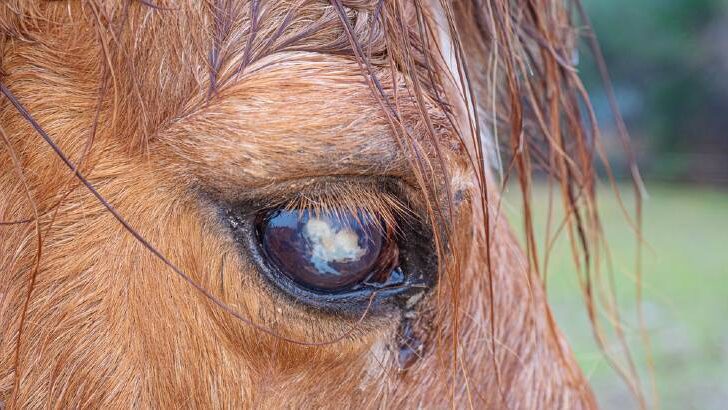Affiliate Disclaimer
As an Amazon Associate I earn from qualifying purchases. It helps me keep the website going. Thank you for your support.
Moon blindness is an unfortunate condition that can affect up to 25% of horses worldwide. It can be hard to detect at first, but it is progressive so the earlier treatments start, the better. The condition can result in a total loss of vision in the affected eye(s). For many, the question will eventually come up – can you ride a horse with moon blindness?
Whether you can ride a horse with moon blindness ultimately depends on the severity of the issue and how well your horse recovers. Every horse will handle it differently, but most are able to continue riding in some capacity. Even blind, many horses can be ridden with the right tools and training.
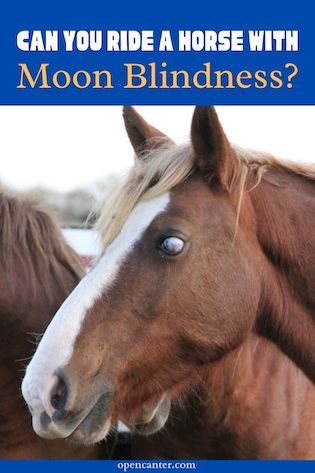
What is Moon Blindness?
The official name for moon blindness is Equine Recurrent Uveitis or ERU. It got the common name “moon blindness” generations ago when people mistakenly believed the disease was tied to the phases of the moon.
This could be due to the condition causing light sensitivity – horses would be more comfortable outside when the sun was down. In any case, we now know that it has nothing to do with the moon but the name has stuck.
Moon blindness sounds scary but it’s actually one of the most common eye problems in horses, and subsequently the leading cause of blindness. It’s an auto-immune issue, meaning the disease causes the horses’ own immune system to attack the eye tissue.
As the name suggests, it’s a recurring issue which means even once treated, it may come back. That’s not to say it’s a hopeless diagnosis, though. With proper medication and management, afflicted horses may still have some quality of life.
The condition remains a bit of a mystery and as of now, it’s believed that all horses are at risk. That said, it has been discovered that Appaloosas are about eight times more likely to get ERU – about 25% of diagnoses are Appaloosas. They’re also more likely to go blind as a result. This suggests a possible genetic link, leaving Appaloosas more vulnerable, but more research must be done here.
Spotting Moon Blindness
Because it’s a progressive and recurring disease, early detection and treatment are important. Unfortunately, it can be hard to distinguish ERU from other types of uveitis or things like ulcers or an abscess. For this reason, a diagnosis often only comes after there’s been a few episodes.
While there is no definitively known cause or trigger for moon blindness, there are some signs and symptoms you can look out for. If you notice any of these happening, keep track of things like time of day, frequency, severity, etc. The more information you can give your vet and other professionals, the better.
- Holding one or both eyes shut due to pain
- Squinting, especially when exposed to sunlight
- Excessive tearing
- Cloudy or blueish look in the cornea
- The pupil is smaller than usual
- The whites of the eye look bloodshot
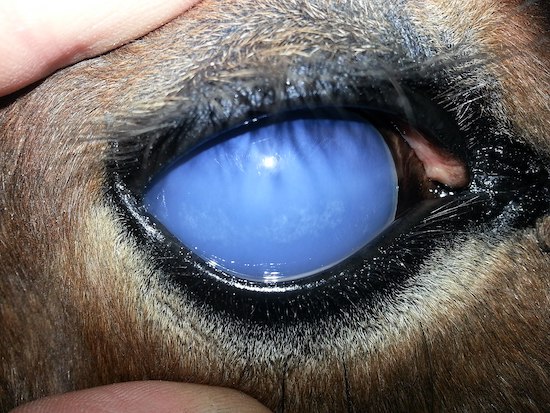
These are things that owners, riders, and other handlers can watch for and keep track of. If you suspect an issue, it’s best to call your veterinarian out right away. They’ll take a closer look at the eye for signs of a uveitis issue.
They’ll look for smaller details, such as:
- The area around the iris may look rough and irregular
- The iris itself may be darker but with no scarring or damage
- Scar tissue may have developed on the iris from continued or recurring inflammation
The iris can be very telling and help with a diagnosis, but an untrained eye may not be able to spot the smaller and more subtle signs.
Treatment Options
There are a few different ways to treat and manage a horse with moon blindness. The main goal of any treatment is to reduce and ideally eliminate the inflammation in the eye. Preserving vision is ideal, but minimizing severe pain is the most important thing.
To treat and minimize an active episode, a series of medications may be prescribed. This can include topical corticosteroids, NSAIDs, and mydriatics to reduce inflammation and also prevent or minimize damage.
While these help a horse get over a flare-up, they aren’t as effective in preventing further occurrences. Long-term management of the disease may require surgical intervention.
Options For Supporting a Horse with Moon Blindness
There are a few options here:
- Something called a cyclosporine implant. This is a device that gives regular therapeutic doses of cyclosporine A for about three years. This has been proven effective in controlling inflammation and minimizing episodes in some horses.
- A core vitrectomy. This procedure removes the core of the vitreous. This removes any debris that’s trapped in the fluids and replaces it with saline. This can improve lost vision, minimize episodes, and even delay the progression of the disease.
- Eye removal. This is often a scary one for horse owners, but it may very well be the best option for your horse. Especially if only one eye is affected, your horse can make a full recovery. One-eye’d horses are more than capable of performing even at high levels, and they’ll do so pain-free. You also won’t have to worry about any recurrence.
These options are usually for more severe cases and the decision should not be taken lightly. Always consult with your vet, they’ll always be able to make the best recommendation.
When treating a horse with moon blindness, it’s also important to watch for complications. Excessive inflammation in the eye can also cause cataracts, glaucoma, retinal damage, and even shrinkage of the eye. Your best bet is to seek the help of a highly trained doctor who has plenty of experience with eye problems.
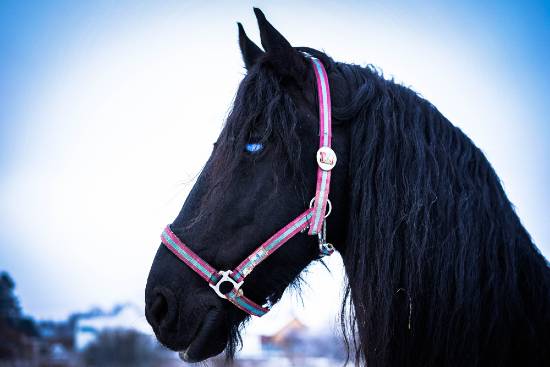
Riding a Horse With Moon Blindness
Regardless of how you choose to approach the issue, the reality is that moon blindness changes your horses’ life. This doesn’t automatically mean their career must end, but you’ll both have to adjust!
If you’ve chosen to manage and minimize episodes or proceed with eye removal, you have a vision-impaired horse either way. Even if you’re able to preserve their vision and delay the disease, it will often progress.
Whether your horse has lost minimal vision or gone completely blind, they’ll need time to accept their new reality. The best thing you can do is give it to them. Horses are resilient and tend to adapt well to curve balls, especially in a safe environment.
Tips for riding a vision-impaired horse:
- First, assess their level of comfort and confidence.
- If possible, let their first rides be with someone with whom they have a strong level of trust.
- Use your voice often while handling and getting them ready, so they always know where you are.
- Give them confidence with very clear aids, and focus on one thing at a time.
- Get them used to verbal cues as well as hand and leg.
All in all, riding a blind or vision-impaired horse isn’t drastically different than a sighted one. The most important thing is that you remain calm and confident.
Some retraining may be necessary for vocal cues and additional aids. If you’re unsure exactly how to proceed, a professional trainer may be able to help. You can read more about riding a vision-impaired horse here.
How to Care for a Blind Horse
If you’re dealing with a blind or mostly blind horse, you’ll have to adjust their lifestyle, as well. Blind horses are perfectly capable of living long and happy lives, but they’ll often require your help:
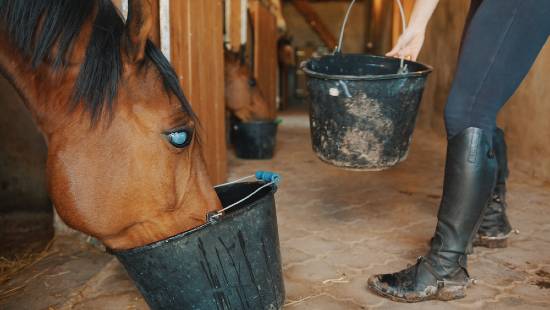
- Place things like feed buckets and water troughs against a wall if possible – inside and outside.
- Post signage around the barn and their stall warning people of a blind horse and to please avoid sudden movements or noises. This helps create a calmer environment for them.
- Blind horses often fall to the bottom of a herd’s pecking order. If possible, turn them out in a flat, even field with a single pasture mate. A calm, quiet horse is suitable, as is a goat, donkey, or even a cow.
- Put a bell on the halter or collar of their companion. This helps the horse keep track of them and not be startled.
- Never trim sensory hairs like their whiskers.
- Keep them on a strict routine.
- If they’re still being ridden, avoid very noisy and windy environments if possible.
- Place soft padding on corners, edges, and any other sharp or blunt surface they may be around.
With a few adjustments and the right care, even completely blind horses can be happy, healthy, and safe. If you’re in the early stages of ERU, try not to get too discouraged. It’s a fairly common condition and even when the inevitable happens, your horse can still thrive.
Final Thoughts
Caring for a horse with moon blindness can be scary and overwhelming. It’s sad to think about your beloved friend and partner losing their site, but it’s not the end of anything. Proper care and treatment can offer your horse a great life. Some are able to continue working, some may have to retire. Early detection is crucial, so the best thing you can do is pay close attention to your horse and never hesitate to call the vet if something is wrong!

